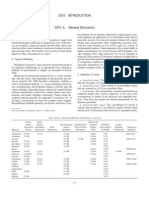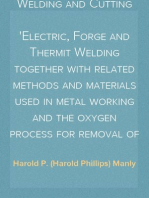0 ratings0% found this document useful (0 votes)
30 viewsTin and Tin Alloys: 1. Scope
Tin and Tin Alloys: 1. Scope
Uploaded by
Burak ÖZBAKIRThis document discusses tin and tin alloys used for food contact applications. It outlines acceptable uses, definitions of performance criteria, and acceptability limits. Tin must contain at least 97% tin and meet limits for undesirable elements like lead, cadmium, and arsenic. Acceptability limits specify maximum contents of these elements, with lead below 0.050%, cadmium below 0.010%, and arsenic below 0.030%. Specific migration limits also apply, such as antimony below 0.01 mg/kg. Tin and tin alloy objects should not contact strongly acidic or basic foods and are not advised for preserving foods.
Copyright:
© All Rights Reserved
Available Formats
Download as PDF, TXT or read online from Scribd
Tin and Tin Alloys: 1. Scope
Tin and Tin Alloys: 1. Scope
Uploaded by
Burak ÖZBAKIR0 ratings0% found this document useful (0 votes)
30 views1 pageThis document discusses tin and tin alloys used for food contact applications. It outlines acceptable uses, definitions of performance criteria, and acceptability limits. Tin must contain at least 97% tin and meet limits for undesirable elements like lead, cadmium, and arsenic. Acceptability limits specify maximum contents of these elements, with lead below 0.050%, cadmium below 0.010%, and arsenic below 0.030%. Specific migration limits also apply, such as antimony below 0.01 mg/kg. Tin and tin alloy objects should not contact strongly acidic or basic foods and are not advised for preserving foods.
Original Title
Tin
Copyright
© © All Rights Reserved
Available Formats
PDF, TXT or read online from Scribd
Share this document
Did you find this document useful?
Is this content inappropriate?
This document discusses tin and tin alloys used for food contact applications. It outlines acceptable uses, definitions of performance criteria, and acceptability limits. Tin must contain at least 97% tin and meet limits for undesirable elements like lead, cadmium, and arsenic. Acceptability limits specify maximum contents of these elements, with lead below 0.050%, cadmium below 0.010%, and arsenic below 0.030%. Specific migration limits also apply, such as antimony below 0.01 mg/kg. Tin and tin alloy objects should not contact strongly acidic or basic foods and are not advised for preserving foods.
Copyright:
© All Rights Reserved
Available Formats
Download as PDF, TXT or read online from Scribd
Download as pdf or txt
0 ratings0% found this document useful (0 votes)
30 views1 pageTin and Tin Alloys: 1. Scope
Tin and Tin Alloys: 1. Scope
Uploaded by
Burak ÖZBAKIRThis document discusses tin and tin alloys used for food contact applications. It outlines acceptable uses, definitions of performance criteria, and acceptability limits. Tin must contain at least 97% tin and meet limits for undesirable elements like lead, cadmium, and arsenic. Acceptability limits specify maximum contents of these elements, with lead below 0.050%, cadmium below 0.010%, and arsenic below 0.030%. Specific migration limits also apply, such as antimony below 0.01 mg/kg. Tin and tin alloy objects should not contact strongly acidic or basic foods and are not advised for preserving foods.
Copyright:
© All Rights Reserved
Available Formats
Download as PDF, TXT or read online from Scribd
Download as pdf or txt
You are on page 1of 1
Page 61
TIN AND TIN ALLOYS
1. Scope
This section deals with tin and tin alloys and objects coated with tin or tin alloy partially tin-
plated which, as finished products, are intended to be in direct repetitive contact with food products.
The products mentionned in sheets "Steels with metallic coating used for packaging"
and "Steel and Stainless Steel with metallic coating (unpackaged)" are not concerned.
The main application examples are the following elements:
• Household articles: measuring instruments, pots, dishes, plates etc.;
• Equipment for the agri-foods industry, metal can closures, etc.
2. Restriction of use for materials
• Do not for use in contact with strongly acidic or basic foods or for heating foods at temperatures up to
150°C.
• Preserving foods in tin or tin alloy objects or objects which have been coated in tin or tin alloys
is not advisable .
3. Definitions of performance criteria for food contact
3.1 Text to be used
3.1.1 Regulatory texts
• Order of 28th June 1912 relating to coloration, conservation and packaging of foodstuffs
and drinks
• Order of 15th November 1945 setting the list of materials likely to be used without adverse
effect on public health in the manufacturing of measuring instruments.
3.1.2 Other texts
• NF EN 611-1 Tin and Tin alloys – Pewter and pewterware
– Part 1: Pewter.
3.2 Criteria to be used
3.2.1 Composition of the tin
Verification of tin content: Sn ≥ 97%
3.2.2 Content in undesirable elements
Looking for the presence of lead, cadmium and arsenic.
3.2.2 Content in other elements
Looking for the presence of antimony and copper. •
Sb ≤ 2.5%; Cu ≤ 1.5%
4. Acceptability limits
4.1 Maximum content in undesirable elements
• Pb ≤ 0.050%
• Cd ≤ 0.010 %
• As ≤ 0.030 %
4.2 Specific Migration Limits
Specific migration of Sb (see. notification from CSAH of 2 December 1999): 0.01 mg/kg.
You might also like
- Guentner Material Selection 2011 EnglishDocument8 pagesGuentner Material Selection 2011 EnglishHoang100% (1)
- BS en Iso 2812-3-2007Document16 pagesBS en Iso 2812-3-2007Burak ÖZBAKIRNo ratings yet
- BS en Iso 2811-4-2011Document18 pagesBS en Iso 2811-4-2011Burak ÖZBAKIRNo ratings yet
- COC - Stainless Steel RackDocument1 pageCOC - Stainless Steel RackMaricel LundenNo ratings yet
- Stainless Steel UsesDocument13 pagesStainless Steel UsesDanny SeeNo ratings yet
- Metal PackagingDocument93 pagesMetal PackagingSanghvi PrabhakarNo ratings yet
- Selection of Materials For FPEDocument26 pagesSelection of Materials For FPEamanuelNo ratings yet
- REACH Safety Information Sheet For StainlessDocument11 pagesREACH Safety Information Sheet For StainlessShaik Mohammed HaikhalNo ratings yet
- Msds Stainless SteelDocument11 pagesMsds Stainless Steelrakesh marwahNo ratings yet
- Materials For Plant ConstructionDocument164 pagesMaterials For Plant ConstructionsarojiniNo ratings yet
- NaNO3 SolutionDocument8 pagesNaNO3 SolutionPham Thanh LyNo ratings yet
- Paper 4 QualityandsafetystandardDocument6 pagesPaper 4 Qualityandsafetystandarddina essamNo ratings yet
- Pharmaceutical Construction MaterialDocument5 pagesPharmaceutical Construction Materialজাকোয়ান হোসেনNo ratings yet
- Packaging of Dairy Products: B. Tech. (Dairy Technology) DT-9 ResourcesDocument9 pagesPackaging of Dairy Products: B. Tech. (Dairy Technology) DT-9 ResourcesAmit Kr GodaraNo ratings yet
- Metal ContainersDocument50 pagesMetal Containerssalmanamjad995No ratings yet
- LECTURE No. 7. LOW MELTING CRYOGENIC ALLOYS-MARAGING-SUPERALLOYSDocument8 pagesLECTURE No. 7. LOW MELTING CRYOGENIC ALLOYS-MARAGING-SUPERALLOYSBizuayehu Tadesse AzeneNo ratings yet
- Indian Regulations On Food PackgingDocument20 pagesIndian Regulations On Food PackgingchoudhurykisanNo ratings yet
- Tin Canned Food ICP MSDocument6 pagesTin Canned Food ICP MSAlexiaaaa12No ratings yet
- Code of Practice For The Prevention and Reduction of Inorganic Tin Contamination in Canned FoodsDocument14 pagesCode of Practice For The Prevention and Reduction of Inorganic Tin Contamination in Canned FoodsNuc LeusNo ratings yet
- CVUAS Metal Cookware 2015Document5 pagesCVUAS Metal Cookware 2015mingsmile1205No ratings yet
- SM 3010 IntroductionDocument3 pagesSM 3010 IntroductionwmlopessNo ratings yet
- BP304T Pe Unit VDocument24 pagesBP304T Pe Unit VArghadeep BhattacharjeeNo ratings yet
- BFR 36Document16 pagesBFR 36Pakii MvNo ratings yet
- Metal Container: Types of Metal Containers Sanitary CansDocument40 pagesMetal Container: Types of Metal Containers Sanitary Cansayesha shafiqueNo ratings yet
- Tayobong MSE 123 Final Output Instructions Due June 7Document2 pagesTayobong MSE 123 Final Output Instructions Due June 7Utak Ma3No ratings yet
- 4 Eric PartingtonDocument4 pages4 Eric PartingtonmarroquinmeridaNo ratings yet
- Tle 8 (Mon)Document47 pagesTle 8 (Mon)Lorry ManuelNo ratings yet
- Bestaendigkeit Von Platin Englisch 24-09-09Document14 pagesBestaendigkeit Von Platin Englisch 24-09-09o3040955No ratings yet
- Metal PackagingDocument19 pagesMetal PackagingRoyal. .AtheistNo ratings yet
- Delfitriani,+13+Priyotomo+Et.+Al+217+ +227Document11 pagesDelfitriani,+13+Priyotomo+Et.+Al+217+ +227Zasyalana Ghany AyuNo ratings yet
- Food Packaging Migration - enDocument4 pagesFood Packaging Migration - enahadsajjadiNo ratings yet
- Pharmaceutical Construction MaterialDocument5 pagesPharmaceutical Construction MaterialMd. Mahade Hasan (153011061)100% (1)
- Basic Principles of Thermal Processing and Bangus BottlingDocument55 pagesBasic Principles of Thermal Processing and Bangus BottlinguddinalbasherNo ratings yet
- Tin PlatecorrosionincannedfoodsDocument7 pagesTin PlatecorrosionincannedfoodsMathaneshan RajagopalNo ratings yet
- Nikal PresentationDocument13 pagesNikal PresentationGhulam AbbasNo ratings yet
- Metallic Denture Base Materials-New1Document57 pagesMetallic Denture Base Materials-New1DRNIRBANMITRA100% (9)
- Safety Data Sheet: Thermic Lance RodsDocument6 pagesSafety Data Sheet: Thermic Lance RodsSaud NishatNo ratings yet
- MFT NotesDocument156 pagesMFT NotesNihad AhmedNo ratings yet
- Workshop NewDocument34 pagesWorkshop NewPelumi OmowaiyeNo ratings yet
- Compliance Tests of Stainless Steel Using The CoE Test GuidelineDocument9 pagesCompliance Tests of Stainless Steel Using The CoE Test GuidelineSteveyNo ratings yet
- Tin PlatecorrosionincannedfoodsDocument7 pagesTin PlatecorrosionincannedfoodspriscilacielobarrientosanchezNo ratings yet
- Unit 2,3,4,5Document44 pagesUnit 2,3,4,5kartikaysinghco20b446No ratings yet
- Reference Document On Best Available Techniques in The Non Ferrous Metals IndustriesDocument807 pagesReference Document On Best Available Techniques in The Non Ferrous Metals IndustriesPutt LaLuNo ratings yet
- Environmental Product Declaration For Tin Coated Steel TinplateDocument20 pagesEnvironmental Product Declaration For Tin Coated Steel TinplatemsmldxbNo ratings yet
- Kitchen Tools and Equipment 1Document12 pagesKitchen Tools and Equipment 1Belia, Aliana MariafeNo ratings yet
- Thermal Processing of FoodDocument19 pagesThermal Processing of Foodtenguria samriddhNo ratings yet
- Recyclable Materials: Why Recycle GlassDocument7 pagesRecyclable Materials: Why Recycle GlassTrung DVNo ratings yet
- Characterisation of Waste: Unit - Ii Lecture - 1Document11 pagesCharacterisation of Waste: Unit - Ii Lecture - 1AashishNo ratings yet
- Tissue Paper ManufacturingDocument43 pagesTissue Paper ManufacturingFhan Sani Seow33% (6)
- En HMG Msds Copper Cathodes 01-01-2022 6Document15 pagesEn HMG Msds Copper Cathodes 01-01-2022 6REIG Ingatlan KftNo ratings yet
- Lead Fire-Assay: Method Code Gravimetric Determination of Gold and SilverDocument5 pagesLead Fire-Assay: Method Code Gravimetric Determination of Gold and SilverAnonymous FfIxH2o9No ratings yet
- Afirm Metals Nickel ReleaseDocument2 pagesAfirm Metals Nickel ReleaseEMS 4AYDNo ratings yet
- Assay AbelDocument14 pagesAssay AbelJoe MartinNo ratings yet
- ASTMB348Document8 pagesASTMB348Ricardo Zárate GodinezNo ratings yet
- Tin Platecorrosionincannedfoods PDFDocument7 pagesTin Platecorrosionincannedfoods PDFAlejandro P. LuengoNo ratings yet
- Metal Packaging MaterialsDocument53 pagesMetal Packaging MaterialsAHMAD ZAIN MUZAKKIINo ratings yet
- Food Contact Surfaces 2Document27 pagesFood Contact Surfaces 2AliNo ratings yet
- Oxy-Acetylene Welding and Cutting Electric, Forge and Thermit Welding together with related methods and materials used in metal working and the oxygen process for removal of carbonFrom EverandOxy-Acetylene Welding and Cutting Electric, Forge and Thermit Welding together with related methods and materials used in metal working and the oxygen process for removal of carbonNo ratings yet
- Metal Contamination of Food: Its Significance for Food Quality and Human HealthFrom EverandMetal Contamination of Food: Its Significance for Food Quality and Human HealthNo ratings yet
- Extractive Metallurgy 2: Metallurgical Reaction ProcessesFrom EverandExtractive Metallurgy 2: Metallurgical Reaction ProcessesRating: 5 out of 5 stars5/5 (1)
- BS en 13523-21-2010Document18 pagesBS en 13523-21-2010Burak ÖZBAKIR100% (2)
- BS en Iso 3681-1998Document12 pagesBS en Iso 3681-1998Burak ÖZBAKIRNo ratings yet
- E Matt Tin Lead SLOTOLET KB 10Document1 pageE Matt Tin Lead SLOTOLET KB 10Burak ÖZBAKIRNo ratings yet
- Material Safety Data Sheet: Tin/Lead AlloysDocument4 pagesMaterial Safety Data Sheet: Tin/Lead AlloysBurak ÖZBAKIRNo ratings yet
- Chemical Composition - Tin PDFDocument1 pageChemical Composition - Tin PDFBurak ÖZBAKIRNo ratings yet
- Lead-Tin-Copper Slotolet CSP 10 1Document1 pageLead-Tin-Copper Slotolet CSP 10 1Burak ÖZBAKIRNo ratings yet
- E Matt Tin Lead LADocument1 pageE Matt Tin Lead LABurak ÖZBAKIRNo ratings yet
- Elaboration of Copper-Tin Alloys Coatings: Effect of GlycineDocument6 pagesElaboration of Copper-Tin Alloys Coatings: Effect of GlycineBurak ÖZBAKIRNo ratings yet
- Effect of Oxygen On Surface Tension of Liquid Ag-Sn AlloysDocument5 pagesEffect of Oxygen On Surface Tension of Liquid Ag-Sn AlloysBurak ÖZBAKIRNo ratings yet
- Tin Pest in Lead-Free Solders: Technical BriefDocument2 pagesTin Pest in Lead-Free Solders: Technical BriefBurak ÖZBAKIRNo ratings yet







































































